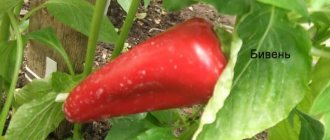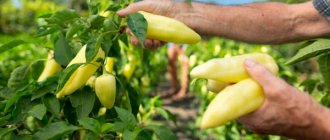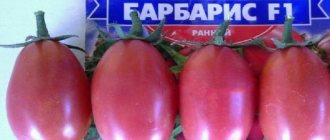Characteristics and description of the variety
The f1 hybrid was developed by Alexey Alekseevich Mashtakov. It was added to the Russian State Register for the North Caucasus (6) region more than 10 years ago, in 2015. Recommended for growing in open ground.
Distinctive features
The type is determinate, plant height is 60-80 cm. The bushes are spreading, the foliage is dense, the leaves are medium-sized, dark green. The first inflorescence is laid above 5-6 leaves, subsequent ones - every 2-3 leaves.
An early ripening species, 80-90 days pass from the moment of germination to full ripening.
Productivity is high, from 1 sq. m, up to 11 kg of fruits are collected, provided that 5-6 seedlings are planted per 1 sq. m. m.
It is characterized by increased resistance to diseases such as tobacco mosaic virus and macrosporiosis, but is susceptible to late blight, so systematic prevention is recommended.
The tomato adapts well to heat and drought, but excess moisture and low temperatures have a detrimental effect.
The crop does not need pinching despite the large number of side shoots, but it cannot do without gartering low-growing bushes. When vegetables ripen, the branches cannot support their weight and break.
Fruit characteristics
The average weight of one fruit is 80-100 g, round shape, rich red color. The taste is excellent, sweet with obvious sourness, the pulp is juicy. There are 4-6 seed chambers. The peel is dense and not prone to cracking. Ripe vegetables are rich in vitamin C.
Universal purpose: excellent for fresh consumption in various dishes and for winter preparations. Tomatoes are also processed into tomato products for the production of juices, ketchups, adjika, and pastes.
Ripe vegetables can be stored for a long time without losing their presentation and can withstand transportation over any distance. For these reasons, entrepreneurs breed the hybrid for sale.
The photo shows Irishka tomatoes.
Diseases and pests
Most often, bushes of this variety are attacked by late blight. The fungus attacks when the humidity is too high. For example, if it rains constantly or there is a lot of dew. All ground parts begin to turn black and dry out. To stop the disease, the bushes need to be treated with antifungal drugs. You can use fungicides such as Bravo or Ridomil. Read more about protection against late blight and varieties resistant to it. And also about Alternaria, Fusarium, Verticillium and other common diseases of tomatoes in greenhouses. And also about measures to combat them.
The hybrid is quite resistant to pest attacks . However, it can be affected by the ubiquitous aphids. Insecticides such as Decis, Iskra M, Fas, Karate, Intavir will save you from this scourge. If these drugs are ineffective, you can use stronger Actellik, Pirimor and Fitoverm. Tomatoes are also often threatened by the Colorado potato beetle and its larvae, thrips, spider mites, and slugs. On our website you will find a series of articles about methods of dealing with them:
- How to get rid of slugs and spider mites.
- Measures to combat thrips, aphids, and Colorado potato beetles.
How to grow seedlings
Sowing seeds for seedlings begins 2 months before planting in the ground. Before sowing, seeds undergo mandatory preparation.
Seed preparation
The seed material is laid out on the table and carefully inspected for visible damage. Then place it in a saline solution for 10 minutes to determine if the seeds inside are empty or not.
Those that float to the surface are not suitable for sowing. Then the grains are disinfected in a pink solution of potassium permanganate for 20 minutes. After disinfection, they are washed with running water and dried.
Reference . After disinfection, up to 30% of seeds lose their viability.
To improve germination, grains are germinated on damp gauze for 2-3 days. To do this, they are laid out on gauze, slightly moistened with warm, settled water and left in a dark place at a temperature of at least 27°C. As the gauze dries, moisten it. After the sprouts appear, the seeds can be sown in the ground.
Container and soil
The soil is prepared from garden soil, humus and peat in equal quantities. All components are thoroughly mixed and the resulting mixture is disinfected with a hot solution of dark potassium permanganate or steamed in an oven at a temperature of 50-60°C for at least 10 minutes.
Plant in a common wooden box or individual plastic cups and peat pots. Planting containers are filled two-thirds with the prepared soil mixture; small drainage holes are first made at the bottom so that excess moisture does not stagnate in the containers.
Sowing
The grains are sown in furrows to a depth of 2 cm. The distance between the seeds is left 2.5-3.5 cm. Sprinkle peat on top, level it, slightly moisten it with warm, settled water and cover the containers with film to create a greenhouse effect. Containers are left in a bright and warm room at a temperature of 23-25°C. At lower temperatures, seedlings appear much later.
The film is periodically removed for ventilation and the soil is slightly moistened as it dries.
Seedling care
When seedlings appear, the containers are moved to a more illuminated place, on the windowsill. As the top layer of soil dries out, water the seedlings with warm, moderate water using a shallow watering can or tablespoon. Water lightly without flooding the sprouts. Excess moisture has a detrimental effect on young roots.
After watering, carefully loosen the soil with a wooden stick or a regular fork. Loosening helps saturate the soil with oxygen.
When 2-3 true leaves appear, the seedlings dive, planting them in separate containers. During picking, weak bushes are disposed of, leaving only strong and healthy ones for further growth.
Reference . When sowing seeds in peat pots, picking seedlings is not required. In addition, the walls of peat containers contain many useful substances that additionally nourish young roots.
During the picking period, the seedlings are fed with liquid fertilizer for tomatoes. This first feeding is most important for weakened bushes.
2-3 weeks before transplanting, the seedlings are hardened off by taking the containers outside for 1 hour during the daytime. Gradually, the interval of time spent outdoors is increased to 12-13 hours. At the same time, the night temperature in the room is reduced to 14°C. The hardening procedure helps to quickly adapt to outdoor conditions after transplantation and strengthens the immunity of young plants.
Features of cultivation
The technology for growing Irishka F1 tomatoes differs little from other varieties. Seeds are purchased in the store - it will not be possible to get plants from independently collected planting material, since it is a hybrid. They are sown in March or until mid-April - after 50-60 days (late May - early June) they must be transferred to open ground.
For growing, you can use various containers - cassettes, peat pots, disposable cups. The soil can be purchased at the store or made up independently, for example, based on the following mixture:
- garden soil - 1 part;
- peat – 1 part;
- sand - a few pinches;
- wood ash.
Important! It is advisable to disinfect the soil. A week before planting, it is kept in a 1% solution of potassium permanganate, then washed and dried.
The seeds are pre-etched in a special product or a weak solution of potassium permanganate. Instructions for growing seedlings are quite simple:
- Plant in containers, lightly sprinkle with soil.
- Moisten generously from a spray bottle.
- Cover with glass and leave at a temperature of 23-25 degrees.
- Provide lighting (total daylight hours are at least 10 hours).
- After 2-3 leaves appear, plant (plant).
- Ventilate the greenhouse periodically; after 2-3 weeks the glass is removed.
- The temperature gradually drops to 20-22 degrees.
- A week before being transferred to open ground, Irishka tomato seedlings begin to harden at a temperature of 17-18 degrees.
They are transferred to open ground in the south in early May, in the middle zone - in the second half of the month. The planting pattern is standard - 60 cm between rows, 50 cm between bushes. Further care is carried out as follows:
- Watering regularly, 2-3 times a week.
- Application of mineral complex fertilizer every 2 weeks.
- Periodic loosening of the soil (can be done immediately after fertilizing).
- Mulching with peat, spruce branches or other materials immediately after planting.
- Tie to a trellis or other reliable support.
Irishka tomatoes, with proper care, give good yields and ripen right on the bush
How to grow tomatoes
After 2 months, the seedlings are transplanted into the ground. They are planted in a greenhouse 2 weeks earlier than in open beds. But do not forget that by the time of replanting the soil should warm up to +15...+17°C.
Landing
The soil for tomatoes is prepared 2 weeks before transplanting. Too dense soil is loosened with lowland peat or river sand. Then the ground is dug up with the addition of mineral fertilizers or wood ash.
Reference . Lowland peat contains a large amount of nutrients, due to which it improves the structure of the soil, saturating it with organic matter.
Planting pattern: 40 cm – distance between seedlings, 60-65 cm – row spacing. For 1 sq. m place no more than 6 plants. Wide row spacing is left for regular ventilation of the bushes and sufficient sunlight.
Transplant the seedlings into holes 20 cm deep . After planting, the holes are watered generously with warm, settled water, compacted and the bushes are left for 1 week to get used to the new place. The most suitable time for transplantation is early morning or evening after sunset.
Further care
Regular watering is established as adaptation progresses, but not more than 2 times a week. On dry and hot days, the amount of watering is increased to 3 times a week. Water with warm water, strictly at the root, without touching the leaves, in the evening or early in the morning.
Attention ! When watering during the day, plant leaves can get burned.
After watering, the soil is loosened, hilled up and weeds with roots are removed. To retain moisture in the soil, the beds are mulched with straw. Weeds are also used as mulch, which, when rotting, provide additional nutrients to the root system.
Over the entire season, the crop is fed three times. The first fertilizing is applied 2 weeks after transplantation. Feed with organic matter or nitrogen complexes. As organic matter, mullein infusion or bird droppings are used in a ratio of 1:15.
The second time is fed during flowering with mineral fertilizers containing mainly potassium and phosphorus.
The third fertilizing is applied during the fruiting period. The fertilizer is the same fertilizer that was used to fertilize it during the flowering period: a full complex of minerals with an emphasis on potassium and phosphorus.
Features of care and possible difficulties
Plants do not require obligatory pinching, although many gardeners prefer to remove all excess shoots up to the first cluster. This technique reduces yields, but protects against the spread of pathogenic fungi. In addition, removing unnecessary shoots ensures better ventilation of the bushes.
As for the garter, opinions are divided: some consider the procedure mandatory, others ignore it. The fact is that in different regions the bushes reach different heights, and with a growth no higher than 50 cm, the plant really does not need fixation.
However, it is necessary to have additional supports on hand in case the fruit-bearing branches cannot support the weight of ripe fruit and begin to break. For gartering, a wooden or metal support is installed next to each bush, to which the fruitful branches are fixed as they grow.
Diseases and pests
The culture is resistant to powdery mildew, tobacco mosaic virus and macrosporiosis, but it does not have immunity to late blight. Late blight is a dangerous fungal disease that often affects the nightshade family and can destroy up to 75% of plantings. Therefore, for those crops that are not endowed with persistent resistance to late blight, it is most important and necessary to carry out appropriate preventive measures.
Prevention measures include loosening the soil, mulching the beds, moderate watering with control of humidity and regular ventilation of closed structures. Also, plants are treated with fungicides several times a season, as these drugs reduce the risk of disease development. The most common drugs used to prevent late blight are Fitosporin and copper sulfate.
If the hybrid is planted in a greenhouse, first replace the top layer of soil, disinfecting the new soil without fail. It is in the upper layer that pathogenic microorganisms and many pest larvae overwinter, which begin to reproduce successfully in the spring. A dark potassium permanganate solution is used as a disinfectant.
If, after all, the fungus has infected the plants, the drug “Hom” is used to combat it. The solution is prepared from 40 g of product and 10 liters of water.
Important ! Potatoes are also processed together with tomatoes, since they are the ones that cause disease in tomato bushes, especially when planted nearby.
The most dangerous pests for tomatoes are aphids, Colorado potato beetles and whiteflies. A soap solution used to treat the stems of affected plants will help get rid of aphids. If there is a large accumulation of it, they are treated with insecticides “Decis” and “Karate”.
The drug “Prestige” is effective against the Colorado potato beetle, and pheromone traps are installed against the whitefly butterfly.
Tomato care
Irishka tomatoes are very unpretentious, so they are also suitable for busy summer residents who have little time to garden. After planting seedlings, tomatoes of this variety need the following:
- Regular watering every 5-6 days. The hybrid should be watered strictly at the root, so as not to wet the leaves and create ideal conditions for the development of late blight. Water for irrigation should be warm. It is better to choose the time in the morning.
- During the season, the Irishka tomato needs to be fed at the root three times. The first fertilizing is carried out 10-14 days after planting the seedlings in the garden bed; organic matter or nitrogenous complexes are used for this. The next stage is before flowering, it is necessary to feed the tomatoes with mineral fertilizers with an emphasis on potassium and phosphorus. When the fruits are formed, add another portion of phosphorus-potassium mineral fertilizers. In the intervals between the main feedings, a couple more foliar feedings are performed - treating the entire bush with fertilizer (especially important during the dry period and during the prolonged rainy season).
- It is not necessary to form a determinate tomato Irishka. But some gardeners speed up the ripening of fruits by cutting off all the stepsons up to the first flower cluster. It should be remembered that this method leads to a decrease in yield.
- The row spacing must be loosened after each rain or watering, or mulch must be used.
- Tomato bushes Irishka F1 must be tied up even before the fruits begin to ripen. If the shoots are not strengthened, they can easily break off under the weight of numerous large tomatoes.
- Bushes must be treated with fungicidal and insecticidal preparations several times during the summer.
Attention! The fruits of the Irishka variety ripen almost simultaneously. Therefore, the gardener must prepare in advance containers for the collected tomatoes and a place for storing them.
Harvesting should be done on time to prevent tomatoes from overripening and not to slow down the ripening of subsequent fruits. Hybrid tomatoes ripen well if picked at the stage of “milk” ripeness.
Nuances for open ground and greenhouses
Hybrid Irishka f1 is recommended for breeding in the North Caucasus District and Central Regions. As a rule, in open ground the taste characteristics are preserved exactly as stated by the manufacturer. However, tomatoes are also grown in cold regions under greenhouse conditions. According to the characteristics and reviews of gardeners, the taste of ripe tomatoes is noticeably different from those from the south.
It is best to prepare the soil in the fall, fertilizing it with organic matter and superphosphate. This way it is better saturated with useful substances, which affects its fertility. Places for planting are chosen to be sunny, protected from drafts and, if possible, elevated.
It is not necessary to form a hybrid. Many gardeners cut off all the stepsons, thereby accelerating the ripening of the fruit. But at the same time, this method leads to a decrease in yield. This is usually done when there is a real threat of late blight.
Planting conditions depend on the region where the crop grows. In the southern area, per 1 sq. m place 6 seedlings, in the middle zone - no more than 5.
Tomato variety Irishka on video
If you grew Irishka F1 tomatoes, please write whether you liked them or not. What was the yield and taste of the fruits like under your climatic conditions? How do you rate the disease resistance of this hybrid? Briefly describe the advantages and disadvantages of this tomato in your opinion. If possible, attach to the comment a photo of the entire bush as a whole or individual fruits that you grew. Thank you!
Your reviews of the Irishka tomato and additions to the description will help many gardeners evaluate this variety more objectively and decide whether it is worth planting or not.
Harvesting and application
Vegetables ripen at the same time, so you should prepare containers intended for collecting fruits in advance. Tomatoes should not be allowed to overripe; it is better to pick them unripe. The tomatoes will take on color on their own at room temperature.
The purpose of ripe vegetables is universal. They are consumed fresh, making a variety of salads, first and second courses. They are baked with meat and fried with eggs, and used to make pizza.
Small tomatoes are great for whole-fruit canning, marinades and pickles. Tomato products do not lose their taste: they make excellent juices, pastes, adjika and ketchups.
Ripe vegetables are stored for a long time and can withstand long-term transportation without losing their presentation. Due to this, the hybrid is grown commercially in many regions.
Early hybrid of tomatoes Irina: for salads and canning
Early hybrids offered by domestic breeders make it possible to significantly shift the timing of tomato harvesting
For gardeners in Siberia, the Urals, and the middle zone, this is very important, since with a short summer season it is necessary to beat the weather every day. Hybrid Irina F1 - will not only delight you with early ripening, but will also surprise you with the excellent taste of the fruits
Young lady in a greenhouse and in a garden bed
There are many varieties and hybrid forms of tomatoes with beautiful sonorous female names. We present another one - a very productive tomato Irina, a first-generation hybrid produced by Agro. However, hybrid seeds are also offered by Plasma Seeds and Siberian Garden.
Ask and receive useful advice from professional gardeners and experienced summer residents.>>
Irina was included in the State Register in 2001; cultivation in open ground, under film covers, is recommended.
Bush up to 1 meter high, stocky, strong. On ridges, plants may be slightly lower, but according to reviews from summer residents, the taste of fruits grown in open ground is an order of magnitude higher than those grown in greenhouses.
There are many leaves, they are medium in size, without pubescence, and rich green in color. The first raceme is formed already above the 6-7th leaf, the next inflorescences occur at intervals of 1-2 leaves. There are 6-7 fruits in a brush.
The tomatoes are round, weighing 100-120 grams. The skin is dense, but not hard, but thin, dark red in color. Typically, such hybrids have a green spot near the stalk, which not everyone likes.
Irina’s fruits do not have it, and there is also no ribbing. The flesh is fleshy and tender. The taste is excellent, and as summer residents note, the tomato is truly sweet. From 4 to 6 chambers are formed inside, there are few seeds.
Where to use the fruits of the Irina variety? They are suitable for salads, slices, and sandwiches. Tomatoes are delicious canned, in marinades, and also as a variety of stews.
Delicious juice, thick sauce, puree, and tomato paste are obtained from the pulp. In a dark place at the appropriate temperature, this tomato hybrid can be stored for up to 1.5 months; it is suitable for transportation.
Advantages and disadvantages
One of the main “advantages” of the Irina tomato is the high taste of the fruit, which is noted by everyone. For hybrids this is a very important, but not the only characteristic.
We list in the description the advantages and disadvantages of the variety.
- Tomato has an early ripening period - 80-95 days.
- Differs in compact sizes.
- Unpretentious.
- Simple care for tomatoes is enough, although you should not forget about removing stepsons and forming a bush.
- Forms large fruits.
- The tomatoes are even in bunches and have an excellent presentation.
- The variety is resistant to diseases, including TMV and fusarium.
- Weakly affected by pests.
- Fruits of universal purpose.
For farmers and hobbyists, the hybrid tomato Irina F1 is an excellent choice, especially since it can be grown in any region. From one bush you can harvest 9-10 kg of tomatoes.
The plant is not afraid of temperature changes, although the yield will be higher under favorable conditions. In shelters and polycarbonate greenhouses, the variety produces larger fruits; in beds the weight will be less.
Advantages and disadvantages of the variety
Positive aspects of the hybrid:
- ability to take root in all regions;
- adaptation to drought and high temperatures;
- ease of care;
- early ripening;
- does not require pinching;
- high fruiting rate;
- excellent taste of fruits;
- amicable maturation;
- high commercial quality;
- long-term storage;
- long transportation;
- versatility in cooking.
The disadvantages include:
- susceptibility to late blight;
- fear of low temperatures;
- impossibility of independently preparing seeds for planting.
Fruit characteristics
- Tomatoes have an even, round shape; they are flattened at the stem and tip.
- The diameter of one tomato reaches about 6 cm, weighing on average 120 g.
- The skin is dense, thin and smooth.
- The pulp is fleshy, juicy and tender.
- Unripe tomatoes are pale green without spots, turning dark red as they ripen.
- Good taste. Tomatoes are sweet because they contain about 3% sugars.
- Inside there are 4 or more seed chambers containing a small number of seeds.
- The concentration of dry substances is about 6%.
- The fruits are stored well in a dry, dark place.
- They are resistant to transportation, during which they do not crack or lose their presentation.
Farmer reviews
Many gardeners admit that they decided to plant a hybrid after seeing photographs that in no way exaggerate the colorfulness of ripe fruits. In most cases, gardeners opt for the Irishka hybrid, refusing to experiment with other species.
Victoria, Irkutsk: “I planted seedlings in the ground at the end of May, they took root well. There were a lot of tomatoes, so the bushes had to be strengthened with supports. We collected the harvest until mid-September - all the fruits are round, even, approximately the same size. I really liked the taste of the tomatoes, especially in the rolls. I’ll definitely plant more!”
Ivan, Vladimir region: “I planted a hybrid in a greenhouse. The bushes grew up to 50 cm, I didn’t tie them up or take stepson. Very friendly good harvest. The vegetables are sweet and sour, ideal for pickling. The dimensions are just right for the jar.”
Description of tomato Irina
Tomato Irina is known as the earliest ripening and most productive species. In addition, it has high taste qualities.
Description of tomato Irina
Characteristics of the variety
Tomato Irina f1 is a hybrid plant. Breeders bred it in the first generation of work. Tomato Irina combines all the positive characteristics of other tomatoes.
This is a determinate species; it does not require pinching of the shoots. Tomatoes grow to a certain height. As soon as it is gained, growth stops. The bush usually reaches 1 m and contains a stocky structure. The stem is wide, with many leaves. Medium sized leaf, dark green.
The Irina f1 variety has a special inflorescence structure. They are located only on sheet 5, after that they go at intervals of 1-2 sheets. Tomato Irina f1 bears fruit early. The harvest is harvested after 95 days. The plant is able to resist diseases that often attack tomatoes. The Irina variety of tomatoes can be grown both in greenhouse conditions and in open areas.
Characteristics of the fetus
The fruits are medium in size. Usually they reach no more than 5 cm in diameter, their weight does not exceed 150 g. The inside of the fruit is fleshy and dense. One bush holds about 4 kg of tomatoes.
According to reviews, the fruits of the Irina f1 tomato variety are very sweet. The amount of sugar in the vegetable reaches about 3.5%. There are few seeds in the inside of the tomato; they are all scattered in separate chambers, so they can be easily removed. Dry matter content is about 5%.
To store such tomatoes, you should choose rooms with low light levels. Humidity did not exceed 35%.
The variety tolerates transportation well.
Product benefits
The plant has good yield
According to the description, the advantages of the variety include:
- precocity;
- high yield and good taste;
- cold resistance;
- resistance to diseases;
- transportability.
Growing rules
Tomato f1 is grown only using the seedling method. Before planting, the seeds are sprayed with a small amount of manganese solution. After this they are left to mature. The distance between seeds should be at least 3 cm.
Irina’s tomatoes must be planted so that new inflorescences do not harm the old ones. The more new inflorescences there are, the longer the seedlings will ripen. Picking is carried out only after the plant has several leaves. Watering is carried out so that water does not fall on the leaves. After about 2 months, the seedlings are transplanted to a permanent place.
Diseases and parasites
According to the description, Irina tomatoes have strong immunity and are rarely exposed to diseases and pests.
Agrotechnics of cultivation and care
Growing hybrid tomatoes Irina is possible both in open and protected ground. It is permissible to plant 50-day-old seedlings, so sowing seeds begins 1.5 months before the expected date of planting the plants in a permanent place.
Hybrid Irina tomato seeds are sown in individual cups or pots, or in boxes. They are filled with ready-made soil mixture for growing vegetables. The seeds are buried 1-1.5 cm, watered with a spray bottle and sprinkled with a thin layer of soil. The cups are covered with film and transferred to a warm and dry room, where they are left until sprouts appear.
After this, the film is removed and the seedlings are transferred to a slightly cooler room with good lighting. Water tomato plants each time only after the top layer of soil has dried out. It is impossible to overwater and overdry seedlings; in the first case, this can lead to rot, in the second - to a slowdown in growth and development.
Irina tomatoes are fertilized with solutions of ready-made complex fertilizers: the 1st feeding is carried out at the stage of formation of 2 true leaves, the subsequent ones - every 2 weeks.
Lighting should be on average 12 hours, so on short spring days it is brought to normal with the help of lamps, turning them on in the morning and evening. If the tomatoes were sown in a common container, then they are picked after they have 2 true leaves.











